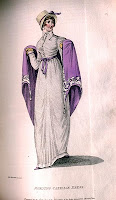January 1812. We are still in the first year of the Regency and here is what the ladies were wearing in January.
Lady’s Monthly Museum
Cabinet of Fashion
A plain muslin dress, made high to fit the bosom with a plaited ruff; the front of the dress confined with coral clasps; earrings and necklace to correspond. Hungarian mantle, with double capes, trimmed with white swansdown, and fixed at the throat with cord and tassels. A small eastern turban, the same colour as the mantle, with white feathers; buff gloves and shoes.
I really like the modesty of this first gown. It has an elegance about it that appeals to me. And the ruff is very Elizabethan/Tudor. Note the hairstyle. She is sporting one, which always appeals to me, the long tress or curl coming over one shoulder.
The second figure is:
A riding dress of fine Georgian cloth, of a green colour, ornamented with frogs militarie in front and finished at the pocket holes with the same. Hat of green velvet, trimmed with white fur. Buff boots and gloves.
Pocket holes, an interesting way to describe them. I always like the idea of military styled riding dresses for ladies, but this view shows the train to perfection. This would ensure the lady's legs are well covered once she is sideways on the horse. I don't know what Georgian cloth is, do you?
So here we see what the ladies were wearing as we approach the end of the first year of the Regency.
Until next time, Happy Rambles
Lady’s Monthly Museum
Cabinet of Fashion
A plain muslin dress, made high to fit the bosom with a plaited ruff; the front of the dress confined with coral clasps; earrings and necklace to correspond. Hungarian mantle, with double capes, trimmed with white swansdown, and fixed at the throat with cord and tassels. A small eastern turban, the same colour as the mantle, with white feathers; buff gloves and shoes.
I really like the modesty of this first gown. It has an elegance about it that appeals to me. And the ruff is very Elizabethan/Tudor. Note the hairstyle. She is sporting one, which always appeals to me, the long tress or curl coming over one shoulder.
The second figure is:
A riding dress of fine Georgian cloth, of a green colour, ornamented with frogs militarie in front and finished at the pocket holes with the same. Hat of green velvet, trimmed with white fur. Buff boots and gloves.
Pocket holes, an interesting way to describe them. I always like the idea of military styled riding dresses for ladies, but this view shows the train to perfection. This would ensure the lady's legs are well covered once she is sideways on the horse. I don't know what Georgian cloth is, do you?
So here we see what the ladies were wearing as we approach the end of the first year of the Regency.
Until next time, Happy Rambles










